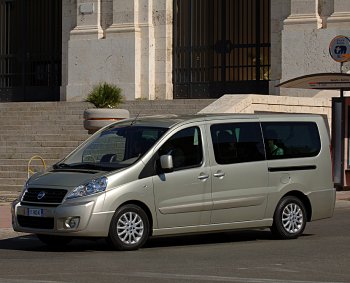|
Superb dynamic
behaviour
|
|
The structural
layout of the New Scudo was designed to guarantee the best
dynamic behaviour from the vehicle. To achieve this goal,
the engineers worked on the structure of the bodyshell and
the front and rear suspension geometry. The New Scudo can
boast very high torsional rigidity, even higher than on the
previous model: under stress, the bodyshell of the short
wheelbase version of the new vehicle only deforms by 0.8
mrad.
Suspension
The suspension layout adopted on the New Scudo gives the
driver total control over the vehicle’s movements,
guaranteeing stability, prompt reactions and pinpoint
steering at all times, in all load conditions. The front
suspension is of the MacPherson type, with triangular lower
struts and an anti-roll bar. The adoption of an independent
wheel system allows strict control of the geometry which in
turn means excellent behaviour on the road, outstanding
comfort and a significant reduction in tyre wear. The rear
suspension is of the ‘torsion axle’ type, i.e. with a
semi-deforming rear axle and Panhard bar. Popular on
people-movers, on the new Scudo this architecture has been
adapted to the more demanding load and working conditions
typical of a light commercial vehicle: the end result is a
good level of performance in terms of dynamic behaviour on
the road, active safety and comfort.
The New Scudo vehicles can also be fitted with self-levelling air
suspension at the rear. Fitted as either standard or optional equipment
depending on the market, this is an innovative feature that
guarantees outstanding comfort, constant trim in all load
conditions (vehicle fully laden or empty, goods positioned
symmetrically or asymmetrically) and a constant overall
height (below 1.90 m on the standard roof version).
|
 |
|
|
|
 |
|
What is more,
air suspension is also available with a loading floor height
that can be adjusted manually (+/- 5 cm) to make
loading/unloading operations even more convenient. For
safety reasons, the trim position can only be adjusted when
the vehicle is stationary and once adjusted it is maintained
up to a speed of 10 km/h. Above that speed, it returns
automatically to the normal on-road height.
Two types of power steering
Depending on the engine, the new Scudo offers two types of
power steering: hydraulic (with the 90 Multijet engine), or
electrohydraulic (with the 120 and 150 Multijet engines).
Both systems were calibrated specifically to enhance the
centring and precision of the steering, while guaranteeing
stress levels suited to the various use situations,
particularly in town (easy parking manoeuvres even on the
heavier versions). Electrohydraulic power steering is
provided by an electric pump system that has been developed
specifically for the new Scudo, and driven by engine speed
and steering wheel rotation speed. Servo assistance is
therefore independent of engine speed.
In addition to the
fact that driving is more enjoyable than with a classic
hydraulic servo assist, this system also helps to reduce
the Scudo's fuel consumption. Regardless of the type of power steering
or tyres mounted, the New Scudo has a turning circle between
kerbs of 12.18 m with the short wheelbase version, and 12.59
m with the longer wheelbase version.
Wheels and tyres
The tyres on the New Scudo were designed specifically to
achieve the best balance between handling, comfort and
styling. In fact, except for the threshold Van version that
mounts 215/65 R15 tyres, the entire range of the New Scudo
fits 16 inch wheels and 215/60 tyres (16” alloys are
available on request).
|
|